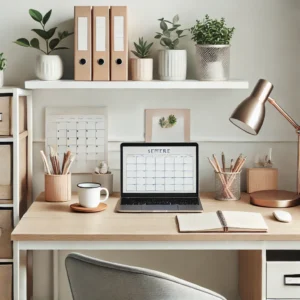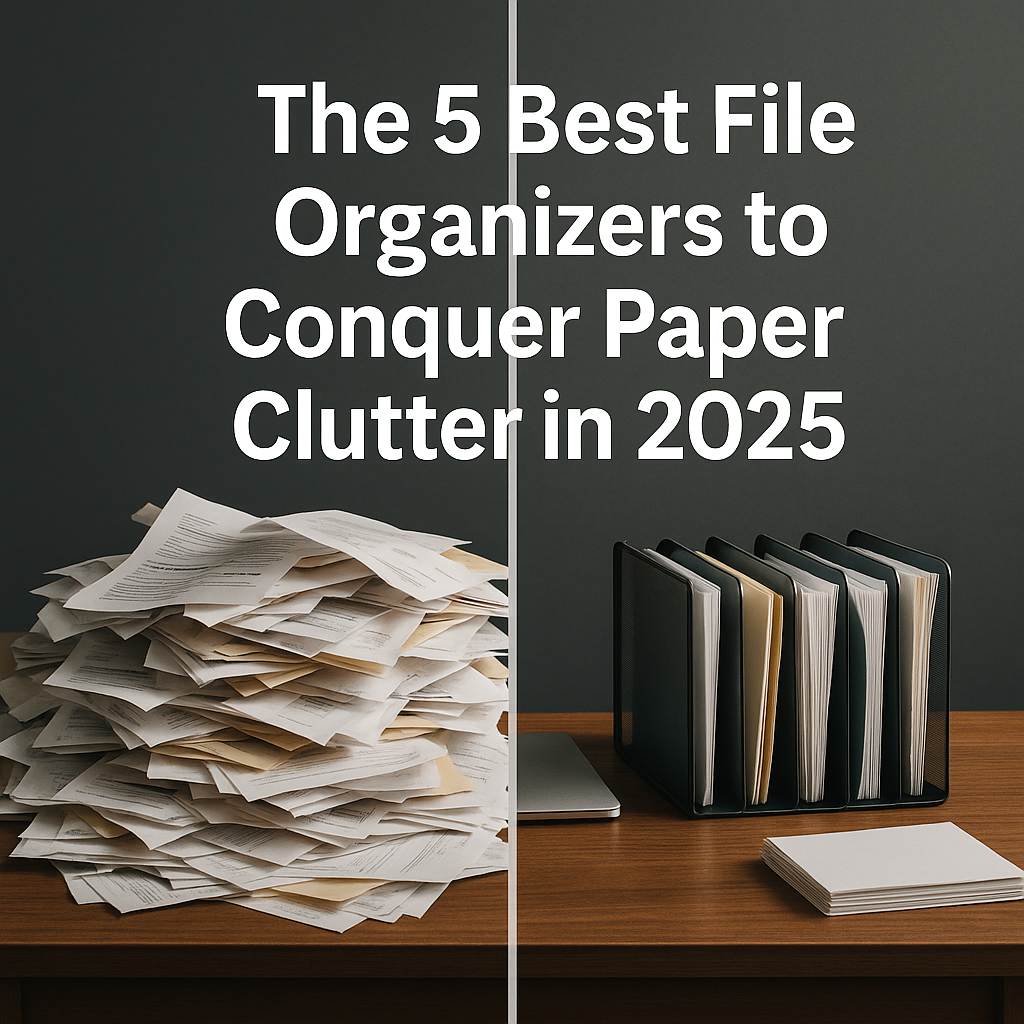How to Stay Organized in 2025: A Comprehensive Guide
Welcome to 2025. If you feel like you’re drowning in a sea of digital notifications, paper piles, and an endless to-do list, you’re not alone. The nature of our work and lives has changed. We’re juggling remote work, endless streams of information, and the constant pressure to do more with less time. The old-school advice to “just make a to-do list” simply doesn’t cut it anymore. True organization in the modern age isn’t about having a tidy desk; it’s about building a holistic system for your life—digital and physical—that reduces stress, boosts focus, and gives you back control.
As a productivity coach, I’ve seen firsthand how a lack of a system can lead to burnout and overwhelm. But I’ve also seen how implementing a clear, simple framework can be life-changing. This guide is designed to be that framework. We’re not just going to give you tips; we’re going to give you proven methodologies used by the world’s most productive people. We’ll cover how to organize your digital files, conquer your physical clutter, and unite it all into a system that helps you stay on top of everything, without losing your mind. Let’s get started.
A Note on Our Recommendations: This article contains affiliate links to tools we genuinely believe in. If you purchase through our links, we may earn a commission at no extra cost to you. Our primary goal is to provide you with the best strategies and resources to succeed.
Part 1: The Foundation – Adopting an Organizational Mindset
Before we touch a single file or label a single box, we need to start here. The most powerful organizational tool you have is your mindset. Without the right approach, even the best systems will fail.
- Progress, Not Perfection: You will not achieve organizational nirvana overnight. The goal is to be 1% more organized today than you were yesterday. Celebrate small wins, like clearing your email inbox or decluttering one drawer.
- Everything Needs a “Home”: The core principle of organization is that every item, digital or physical, has a designated place to live. When you’re done with something, it goes back to its home. Clutter is simply the result of unmade decisions.
- Schedule Your Organizing: Don’t wait for inspiration. Block out 15-30 minutes on your calendar each week for an “organizational reset.” Use this time to process your inboxes, tidy your desk, and plan the week ahead. Consistency is everything.
Part 2: Taming Digital Chaos with the PARA Method
Our digital lives are often far more cluttered than our physical ones. The PARA method, developed by productivity expert Tiago Forte, is a simple yet revolutionary way to organize all your digital information—from files and notes to emails and bookmarks.
What is P.A.R.A.?
PARA is an acronym for the only four top-level folders you need to manage your entire digital life:
- Projects: Short-term efforts you’re actively working on with a clear goal (e.g., “Plan Q4 Marketing Campaign,” “Renovate the Kitchen,” “Finish 2025 Tax Prep”).
- Areas: Long-term responsibilities with a standard to maintain (e.g., “Finances,” “Health & Fitness,” “Parenting,” “Professional Development”).
- Resources: Topics of ongoing interest or reference material (e.g., “Project Management Articles,” “Favorite Recipes,” “Travel Ideas,” “Stoic Philosophy”).
- Archives: Inactive items from the other three categories (e.g., completed projects, areas you’re no longer responsible for, resources that are no longer relevant).
By organizing by actionability (Projects > Areas > Resources), you ensure the information you need most is always at your fingertips. Implement these four folders in your cloud storage (Google Drive, Dropbox), your notes app (Evernote, Notion), and your email client.
Part 3: Conquering Physical Clutter with a 5-Step System
For your physical space—be it your office, kitchen, or closet—a systematic approach is key. Don’t try to organize a whole room at once. Instead, pick one small, defined zone (like your desk, one kitchen counter, or a single bookshelf) and follow these steps.
-
Define Your Zone
Clearly identify the boundaries of the space you’re organizing. For example, “the top of my desk and the top drawer.” This prevents the task from becoming overwhelming.
-
Empty and Clean
Take everything out of the zone. Everything. Pile it all on the floor or another surface. Now, give the empty space a thorough cleaning. Starting with a blank slate is psychologically powerful.
-
Sort and Purge (The 3-Box Method)
Go through the pile item by item and make a quick decision. Sort each item into one of three boxes: Keep, Donate/Trash, or Relocate (for items that belong in a different zone).
-
Organize the “Keep” Pile
Now, focus only on the items you’re keeping. Group similar items together (e.g., all pens, all notebooks, all charging cables). This is where you identify the need for containers or organizers.
-
Return and Label
Put the organized items back into your clean zone. Give everything a designated “home.” Use a label maker for bins, folders, and drawers. This is the most crucial step for long-term maintenance.
Part 4: Your Unified System: GTD and Time Blocking
Now, how do you manage the actual *work* that needs to be done? We’ll combine two powerful methods: Getting Things Done (GTD) for task management and Time Blocking for execution.
The Core of GTD: Capture Everything
The central idea of David Allen’s Getting Things Done (GTD) method is to get tasks and ideas out of your head and into a trusted system. Your brain is for having ideas, not holding them. Use a single “inbox” to capture everything that comes your way—a task from your boss, a brilliant idea for a side hustle, a reminder to buy milk. This inbox can be a physical notebook, a digital app, or a smart notebook.
From To-Do List to To-Do Schedule: Time Blocking
A long to-do list is a recipe for overwhelm. Time Blocking is the practice of taking your tasks from that list and giving them a specific block of time on your calendar. Instead of a list that says “Write report,” your calendar will have a block from 1 PM to 3 PM on Tuesday labeled “Work on Q3 Sales Report.” This approach ensures you’ve actually allocated the time to do the work you’ve planned.
Part 5: Essential Tools for Organization in 2025
The right tools can make implementing these systems much easier. Here are five essentials that bridge the gap between physical and digital organization.

Rocketbook Smart Reusable Notebook
The perfect tool for the GTD “capture” habit. Write notes and to-dos with a traditional pen-and-paper feel, then use the Rocketbook app to scan and send your notes directly to the correct folder in your digital PARA system (e.g., send meeting notes to a Project folder in Google Drive). Then, just wipe the page clean. It’s the ultimate bridge between analog and digital.
See it on Amazon
Brother P-Touch Label Maker
A label maker is the hero of physical organization. Use it to label file folders, storage bins, pantry shelves, charging cables, and drawers. When everything has a clear, legible label, you and your family are far more likely to put things back in their proper “home,” which is the key to maintaining order.
See it on Amazon
Marbrasse Wooden Desk Organizer
Your desk is command central. A good organizer provides a designated home for the items you use most, preventing the dreaded “pile-up.” This model has vertical slots for files, compartments for pens and supplies, and a shelf for your phone, keeping your immediate workspace clear and focused.
See it on Amazon
Amazon Basics Collapsible Fabric Storage Cubes
For larger-scale home organization—in closets, playrooms, or offices—these versatile fabric bins are indispensable. They’re perfect for sorting items during a decluttering session and fit perfectly in cube shelving units. Use your label maker to clip a label to the handle, and you’ll know exactly what’s inside at a glance.
See it on Amazon
Leuchtturm1917 Dotted A5 Notebook
While digital tools are great, a dedicated analog notebook for planning and reflection is invaluable. The Leuchtturm1917 is the gold standard for bullet journaling and daily planning. Use it for your weekly reset, to time block your week, or to journal. Its high-quality paper and durable build make it a joy to use daily.
See it on AmazonFrequently Asked Questions About Getting Organized
I’m too overwhelmed to even start. What’s the absolute first step?
The “Two-Minute Rule” from GTD is perfect for this. If you see a task that can be completed in two minutes or less, do it immediately. Take out the trash, reply to that one email, put your shoes away. Stringing together a few of these tiny wins builds momentum and confidence, making it easier to tackle bigger projects.
Digital or physical organization: which is better?
The best system in 2025 is a hybrid one. Use digital tools for what they’re best at: storage, search, and collaboration (the PARA method). Use physical tools for what they’re best at: focused, deep thinking, planning, and brainstorming (a planner or notebook). The key is to have a clear workflow between them, like using the Rocketbook to digitize your analog notes.
How do I stay organized when I live with messy people?
Focus on what you can control: your own belongings and designated common areas. Lead by example rather than by nagging. Make organization as easy as possible for others by using clear labels and accessible bins. For shared spaces like the kitchen, have a family meeting to agree on a basic standard of tidiness that everyone can live with.
What is the most common mistake people make when trying to get organized?
The most common mistake is buying organizing products *before* decluttering. People buy beautiful bins and containers, hoping it will solve the problem, only to find they’re just storing clutter more neatly. You must purge and sort your belongings *first*. Only then will you know what kind of storage solutions you actually need.
Your Journey to an Organized Life Starts Now
Getting organized is not a one-time event; it’s an ongoing practice. The methods and tools in this guide provide a powerful, modern framework, but the most important step is the first one. Pick one area—your digital desktop, your kitchen counter, your weekly schedule—and apply one of these principles today. Don’t wait for the “perfect” time. Start now, be consistent, and you’ll find that the sense of calm and control you’ve been searching for is well within your reach.


